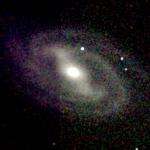Messier 109
 | |
| Barred spiral galaxy M109 | |
| Observation data Epoch J2000 | |
|---|---|
| Constellation | Ursa Major |
| Right ascension | 11h 57m 36.0s[2] |
| Declination | +53° 22′ 28″[2] |
| Apparent dimension (V) | 7.6 × 4.7 moa[2] |
| Apparent magnitude (V) | 10.6[2] |
| Characteristics | |
| Type | SB(rs)bc,[2] LINER/HII[2] |
| Astrometry | |
| Heliocentric radial velocity | 1048 ± 1[2] km/s |
| Redshift | 0.003496 ± 0.000004[2] |
| Galactocentric velocity | 1121 ± 3[2] km/s |
| Distance | 83.5 ± 24 Mly (25.60 ± 7.36 Mpc) |
| Other designations | |
| Database references | |
| SIMBAD | Search M109 data
|
| See also: Galaxy, List of galaxies | |
Messier 109 (also known as NGC 3992) is a barred spiral galaxy exhibiting a weak inner ring structure around the central bar approximately 83.5 ± 24 million light-years[3] away in the constellation Ursa Major. M109 can be seen southeast of the star Phecda (γ UMa).
History
Messier 109 was discovered by Pierre Méchain in 1781. In 1783 Charles Messier catalogued NGC 3992 as his 109th object.
Between the 1920s through the 1950s, it was considered that Messier objects over 103 were not official, but in later years the additions became more widely accepted. David H. Levy mentions the modern 110 object catalog while Sir Patrick Moore gave the original to 104 but has M105-M109 listed as an addendum. By the late 1970s all 110 objects are commonly used among astronomers as they still are today.
General information

In March 1956, supernova 1956A was observed in M109. SN 1956A was a type Ia supernova in the southeast part of the galaxy, glowing at magnitude 12.8 to 12.3 at its maximum. SN 1956A has been the only supernova observed in M109 since its discovery. It is also by far the most distant object in the Messier Catalog, followed by M91
M109 has three satellite galaxies (UGC 6923, UGC 6940 and UGC 6969) and possibly might have more. Detailed hydrogen line observations have been obtained from M109 and its satellites. M109's H I distribution is regular with a low level radial extension outside the stellar disc, while at exactly the region of the bar, there is a central H I hole in the gas distribution. Possibly the gas has been transported inwards by the bar, and because of the emptiness of the hole no large accretion events can have happened in the recent past.[4]
Environment
M109 is the brightest galaxy in the M109 Group, a large group of galaxies located in the constellation Ursa Major that may contain over 50 galaxies.[5][6][7][8]
See also
- NGC 1300 - a similar barred spiral galaxy
References
- ↑ Kaufmann, D.E.; Contopoulos, G. (1996). "Self-consistent models of barred spiral galaxies". Astronomy & Astrophysics. 309: 381–402. Bibcode:1996A&A...309..381K.
- 1 2 3 4 5 6 7 8 9 10 11 12 13 14 "NASA/IPAC Extragalactic Database". Results for M 109. Retrieved 2006-10-10.
- ↑ It is also by far the most distant object in the Messier Catalog, followed by M91 "Distance Results for MESSIER 109". NASA/IPAC Extragalactic Database. Retrieved 2010-05-02.
- ↑ Bottema, Roelof; Verheijen (2002). "Dark and luminous matter in the NGC 3992 group of galaxies". Astronomy and Astrophysics. 388 (3): 793. Bibcode:2002A&A...388..793B. arXiv:astro-ph/0204335
 . doi:10.1051/0004-6361:20020539.
. doi:10.1051/0004-6361:20020539. - ↑ R. B. Tully (1988). Nearby Galaxies Catalog. Cambridge University Press. ISBN 0-521-35299-1.
- ↑ P. Fouque; E. Gourgoulhon; P. Chamaraux; G. Paturel (1992). "Groups of galaxies within 80 Mpc. II - The catalogue of groups and group members". Astronomy and Astrophysics Supplement. 93: 211–233. Bibcode:1992A&AS...93..211F.
- ↑ A. Garcia (1993). "General study of group membership. II - Determination of nearby groups". Astronomy and Astrophysics Supplement. 100: 47–90. Bibcode:1993A&AS..100...47G.
- ↑ G. Giuricin; C. Marinoni; L. Ceriani; A. Pisani (2000). "Nearby Optical Galaxies: Selection of the Sample and Identification of Groups". Astrophysical Journal. 543 (1): 178–194. Bibcode:2000ApJ...543..178G. arXiv:astro-ph/0001140
 . doi:10.1086/317070.
. doi:10.1086/317070.
External links
| Wikimedia Commons has media related to Messier 109. |
- "Messier 109". SEDS. Retrieved 2005-08-11.
- Messier 109 on WikiSky: DSS2, SDSS, GALEX, IRAS, Hydrogen α, X-Ray, Astrophoto, Sky Map, Articles and images
- M109
Coordinates: ![]() 11h 57m 36s, +53° 22′ 28″
11h 57m 36s, +53° 22′ 28″
